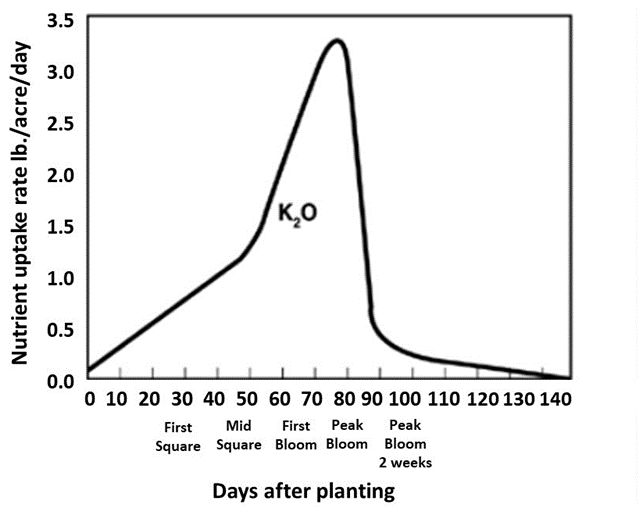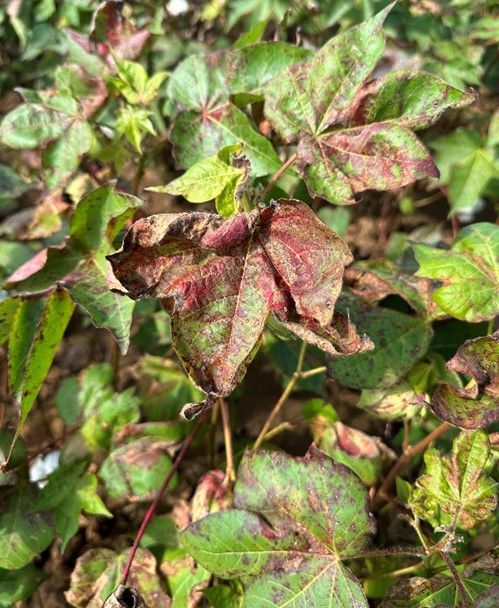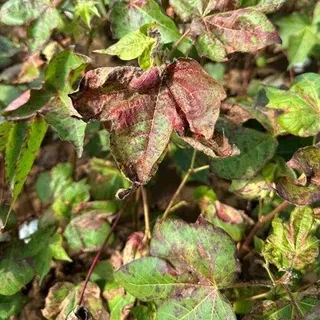Potassium Deficiency in Cotton: Causes, Symptoms, and Considerations
Introduction
Cotton is a perennial crop of the tropics and subtropics with an indeterminate growth pattern. It is one of the important row crops, occupying about 90,000 acres in Florida (USDA 2023). Nutrient management plays an important role in cotton production and directly affects cotton yield and lint quality. Cotton has a very high potassium (K) requirement for proper growth, boll formation, and optimal fiber quality (Oosterhuis 2002; Denton et al. 2023). Potassium deficiency in cotton can result in low lint quality and inadequate boll development (Abaye 2019). The purpose of this publication is to inform cotton producers, Extension agents, crop advisors, and consultants about the role, deficiency, and management of potassium in cotton production.
Role of Potassium in Cotton
Potassium is one of the essential macronutrients required by plants for different physiological and biochemical functions that result in crop growth and development. Also, K is the second largest nutrient required by cotton after nitrogen, as K plays vital roles in important plant processes such as enzyme activation, protein synthesis, and photosynthesis (Prajapati and Modi 2012). Previous studies indicate that cotton requires K for different enzyme activation, osmoregulation, and pH regulation (Ashfaq et al. 2015). Other than that, K also influences transpiration and translocation, as K is required to maintain turgor pressure in stomatal cells and stomata opening. It has also been found that optimum K levels in cotton plants can relieve abiotic and biotic stresses. According to the literature, on average, 52 lb of K2O are required to produce a bale of cotton (Abaye 2019).
Additionally, K is essential for boll formation in cotton because bolls are a major sink for K. A higher K amount in cotton is needed to maintain turgor pressure in bolls, which is essential for fiber elongation. Turgor pressure is the pressure within the cell that pushes the cell membrane against the cell wall. During the reproductive stage, cotton starts accumulating most of its K in reproductive parts (i.e., bolls) and has higher K requirements. Due to this demand, cotton takes up a large amount of K during a six-week period beginning at early flowering (Figure 1).

Credit: Adapted from Mullins and Burmester (1990)
Potassium Deficiency and Symptoms
Similarly to plants lacking in other macronutrients, K-deficient cotton plants show symptoms that are visible throughout the plant canopy. The major K deficiency symptom appears in leaves as yellowish-white mottling around tips and margins and between veins, which dies and changes to brown spots. After breaking down, leaf margins and tips start to curl. As K deficiency continues, the whole leaf turns reddish-brown, dries, and becomes brittle (Figure 2). In cases of severe deficiency, leaves drop prematurely and halt boll formation, or develop very small bolls which may fail to open and have low fiber quality.

Credit: Kulpreet Singh
Early-season K deficiency symptoms are first visible in the lower canopy (older leaves) as K is used for the new growth in the upper canopy, whereas late-season K deficiency symptoms develop in the upper canopy as bolls in the lower canopy act as a sink for K (Denton et al. 2023). Late-season deficiency usually occurs at the late bloom or boll formation stage as K uptake peaks at 2–4 lb per acre per day after a few weeks of flowering initiation (Oosterhuis 2002). The peak uptake of K in the late season explains the deficiency that occurs under a single preplant K application.
Factors Causing Potassium Deficiency
Cotton is very sensitive to K deficiency and has high K demand compared to other major agronomic crops. Some of the other factors that result in K deficiency in cotton are explained below.
Low-CEC Soils
The main factor contributing to K deficiency in cotton is the inadequate amount of available K in soil. The availability of K depends on the cation exchange capacity (CEC) of the soil. The CEC represents the ability of soil to hold K and other cations for crop uptake. The CEC depends on the soil texture and soil organic matter. Sandy soils generally have low CEC compared to clay soils. Although K is considered an immobile nutrient in soil, K leaching below the root zone can still occur and negatively impact K availability for crop uptake, especially in low-CEC soils (i.e., less than 5 mEq/100 g).
Soil Moisture
Soil moisture is another factor that affects cotton K uptake. Cotton takes up K mainly by diffusion, which means K moves from areas of high concentration (soil) to areas of low concentration (roots). This diffusion process is facilitated by water (Kuchenbuch et al. 1986). The K deficiency is observed in low moisture conditions, and it can negatively affect the cotton yield. Use of cover crops to increase soil organic matter (Newman et al. 2007) can facilitate better water retention and may reduce the risk of K deficiency in Florida soils. However, there is no real-time data available regarding reduced K deficiency in cotton in response to use of cover crops in Florida soils. Late-season K deficiency in cotton and rapid cover crop biomass decomposition due to hot and humid conditions might limit the benefit of cover crops in mitigating K deficiency in cotton. Therefore, it is important to maintain adequate soil moisture content through proper irrigation to avoid K deficiency.
Soil pH and Cation Imbalance in the Soil
The calcium (Ca2+) and magnesium (Mg2+) ions impact the K availability and its uptake by plant roots. The imbalance of Mg2+ and K+ ions in soil can reduce K uptake by roots because Mg2+ ions compete with K+ for root sites for uptake. Potassium fertilization can address this issue to balance Mg2+ and K+ ions. On the other hand, Ca ions in soil increase K availability because Ca2+ ions displace K+ from soil particles and make them available for uptake.
Soil pH is one important factor that influences K displacement in soils for plant uptake. Soils with low pH have fewer Ca2+ ions and less displacement of K from soil particles, making K+ less available for plant absorption. Low soil pH can be corrected by amending the soil with lime (Hargreaves 2015). Perform soil testing before planting in order to plan fertilization and provide adequate soil amendments.
New Cotton Genotypes
New high-yielding, early-maturing varieties have exhibited increased K deficiency compared to older varieties. This increase can be attributed to lower accumulation of K before flowering due to the short period of time. Decreased root activity after the start of flowering further compounds K deficiency. In addition, varieties with high yield potential have a high demand for K and require earlier K fertilization compared to older varieties (Oosterhuis 2002). Different cotton genotypes in cotton variety demonstration plots at the UF/IFAS West Florida Research and Education Center (UF/IFAS WFREC) in Jay, FL, were rated for K deficiency. The rating is given on a scale of 1–10, where 1–3 represents low K deficiency, 4–7 represents medium K deficiency, and 8–10 represents high K deficiency (Table 1). The rating was given based on visual K deficiency symptoms present throughout the crop canopy and rows.
Table 1. Potassium deficiency rating on different cotton varieties at UF/IFAS WFREC in Jay, FL, in 2023.
Cotton Root Morphology and Related Factors
Root density and root surface area play a major role in K uptake in cotton. Low root density and total root surface area of cotton make it more prone to K deficiency compared to other crops. Factors such as hardpans or nematode infestation, which restricts root growth, can further contribute to K deficiency.
Considerations for Potassium Fertilization
Fertilization is the most important aspect of cotton production. The available sources for K fertilization through soil are muriate of potash (MOP) and sulfate of potash (SOP). MOP is preferred over SOP because of its low cost (Suresh Kumar 2023). The K fertilizer can be applied through preplant broadcasting, preplant banding, or side-dress after emergence. After broadcasting, incorporating fertilizer in the soil facilitates K uptake (Oosterhuis 2002). The amount of K fertilizer applied should follow the soil test recommendations. In the Cotton Belt, K fertilization is done in preplant single application. This practice is easy and cost-effective because of the reduced number of trips over the field for fertilization. However, several problems are associated with single application because a large amount of applied K is prone to leaching, especially in sandy soils. Early-season single K application can also result in late-season K deficiency because K demand is higher during the boll setting, and most K uptake occurs after squaring. Additionally, K is not actively mobile in soil. Therefore, roots must intercept K in the soil for the uptake to occur. However, root activity is reduced after flowering (Oosterhuis 2002). Considering the sandy soils of Florida, this problem can be managed via split K application by applying one-third at plant and two-thirds at squaring to early bloom to meet cotton K requirements (Wright et al. 2007).
Another strategy can be preplant single K fertilization coupled with mid-season foliar K application. Potassium nitrate (KNO3) is the preferred fertilizer for foliar application because of its high solubility (Suresh Kumar 2023). Foliar K application can be beneficial to mitigate late-season K deficiency. Foliar K application needs to be considered on soils with high sand content, and low K when early-maturing varieties are used (University of Georgia Extension 2021). The research from Georgia reports two foliar applications of 5–10 lb of K2O during peak bloom are effective for mitigating K deficiency. The need for further K foliar applications can be determined using petiole analysis during early bloom. Researchers have found that petiole K and leaf blade K concentrations are strongly correlated. The petiole sampling should be done from the fourth or fifth fully developed leaf blade, the most active leaf physiologically, from the top of the mainstem for K analysis (Cotton-Petiole-Sampling.pdf (watersag.com)). According to the literature, the optimum level of K in the petiole from early bloom to boll opening should be 2–4 percent (Oosterhuis 2000). Foliar applications should be scheduled based on results from petiole sampling.
Summary
Potassium is an essential macronutrient for boll development, fiber elongation, and fiber quality in cotton.
Potassium deficiency symptoms appear in leaves as yellowish-white mottling around tips and margins. In cases of severe deficiency, the mottling turns reddish-brown, and leaves become brittle.
Cotton has higher K demand during the reproductive stage because bolls are a major sink for K. Therefore, early field scouting, especially on sandy soils, should be done to address potential deficiencies that can manifest at this stage.
Factors such as soil CEC, soil moisture, soil pH, cation imbalance, hardpans, root nematode infestations, and different cotton genotypes can result in K deficiency.
Soil-applied K fertilization should be based on soil test recommendations and can be done in split applications to avoid late-season K deficiency.
Single-split K fertilization can be coupled with foliar K application to mitigate late-season K deficiency, especially on sandy soils.
Petiole sampling during early bloom should be considered to determine the need for foliar K application and mitigate late-season K deficiency, if there is any.
References
Abaye, A. O. 2019. “Potassium Fertilization of Cotton.” https://www.pubs.ext.vt.edu/content/dam/pubs_ext_vt_edu/418/418-025/418-025.pdf
Ashfaq, A., N. Hussain, and M. Athar. 2015. “Role of Potassium Fertilizers in Plant Growth, Crop Yield and Quality Fiber Production of Cotton—An Overview.” FUUAST Journal of Biology 5 (1): 27–35.
Denton, S., D. Dodds, J. Kurts, J. Gore, T. Raper, M. Cox, and J. Dhillon. 2023. “Effect of Potassium Application Rate on Cotton Growth and Yield Under Irrigated and Dryland Conditions.” Agronomy Journal 115 (1): 395–407. https://doi.org/10.1002/agj2.21245
Hargreaves, P. 2015. “Soil Texture and pH Effects on Potash and Phosphorus Availability.” https://www.pda.org.uk/soil-texture-and-ph-effects-on-potash-and-phosphorus-availability/
Hu, W., J. Yang, Y. Meng, Y. Wang, B. Chen, W. Zhao, and Z. Zhou. 2015. “Potassium application affects carbohydrate metabolism in the leaf subtending the cotton (Gossypium hirsutum L.) boll and its relationship with boll biomass.” Field Crops Research 179:120–131. https://doi.org/10.1016/j.fcr.2015.04.017
Kuchenbuch, R., N. Claassen, and A. Jungk. 1986. “Potassium Availability in Relation to Soil Moisture: I. Effect of Soil Moisture on Potassium Diffusion, Root Growth and Potassium Uptake of Onion Plants.” Plant and Soil:221–231. https://doi.org/10.1007/BF02375074
Mullins, G. L., and C. H. Burmester. 1990. “Dry Matter, Nitrogen, Phosphorus, and Potassium Accumulation by Four Cotton Varieties.” Agronomy Journal 82 (4): 729–736. https://doi.org/10.2134/agronj1990.00021962008200040017x
Newman, Y. C., D. W. Wright, C. Mackowiak, J. M. S. Scholberg, and C. M. Cherr. 2007. “Benefits of Cover Crops for Soil Health: SS AGR 272/AG277, 11/2007.” EDIS 2007 (20). https://doi.org/10.32473/edis-ag277-2007
Oosterhuis, D. M. 1999. “Foliar Potassium Fertilization of Cotton.” In Frontiers in Potassium Nutrition, edited by D. M. Oosterhuis and G. A. Berkowitz. 87–99. Canada: Potash and Phosphate Institute.
Oosterhuis, D. M. 2002. “Potassium Management of Cotton.” In Potassium for Sustainable Crop Production. 331–346.
Prajapati, K., and H. A. Modi. 2012. “The Importance of Potassium in Plant Growth - A Review.” Indian Journal of Plant Sciences 1 (02-03): 177–186. https://doi.org/10.4236/ajps.2012.32021
Reddy, K. R., H. F. Hodges, and J. J. Varco. 2000. “Potassium Nutrition of Cotton.” Bulletin 1094:1–10. Mississippi State, MS: Mississippi Agricultural & Forestry Experiment Station. https://www.researchgate.net/profile/K-Reddy-20/publication/228609146_Potassium_nutrition_of_cotton/links/004635283aa49e8d1d000000/Potassium-nutrition-of-cotton.pdf
Stevens, G. 2019. “Cotton Fertility Management.” https://extension.missouri.edu/publications/g4256
Suresh Kumar, S. 2023. “Influence of Potassium Fertilizer Application Timing on Cotton Production as Related to Soil Potassium on U.S. Coastal Plain Soils.” All Theses. 4026. https://tigerprints.clemson.edu/all_theses/4026?utm_source=tigerprints.clemson.edu%2Fall_theses%2F4026&utm_medium=PDF&utm_campaign=PDFCoverPages
University of Georgia Extension. 2021. Georgia Cotton Production Guide. https://secure.caes.uga.edu/extension/publications/files/pdf/AP%20124-1_1.PDF
USDA. 2023. “2023 Cotton Planted Area in the US.” https://downloads.usda.library.cornell.edu/usda-esmis/files/j098zb09z/hh63v8465/zg64w269x/acrg0623.pdf
Wright, D., J. Marois, and J. Rich. 2007. “Cotton Cultural Practices and Fertility Management.” SS-AGR-194. Gainesville: University of Florida Institute of Food and Agricultural Sciences. https://edis.ifas.ufl.edu/AG200




